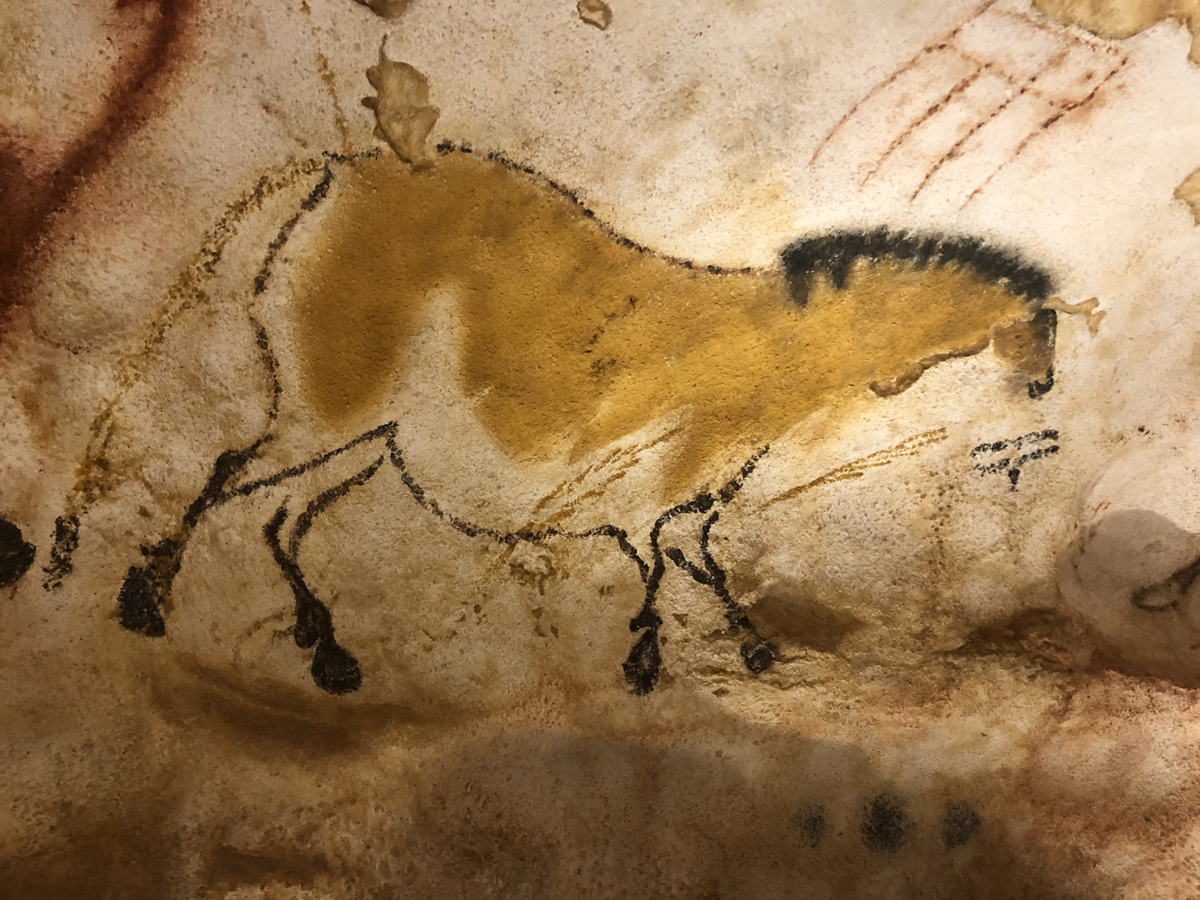


An article by Barbara Ehrenreich on theguardian.com - ‘Humans were not centre stage’: how ancient cave art puts us in our place - looks at why, in our self-obsessed age, the anonymous, mysterious cave art of our ancient ancestors is exhilarating.

Extract:
'In 1940, four teenage boys stumbled, almost literally, from German-occupied France into the Paleolithic age. As the story goes – and there are many versions of it – they had been taking a walk in the woods near the town of Montignac when the dog accompanying them suddenly disappeared. A quick search revealed that their animal companion had fallen into a hole in the ground, so – in the spirit of Tintin, with whom they were probably familiar – the boys made the perilous 15-metre descent to find it. They found the dog and much more, especially on return visits illuminated with paraffin lamps. The hole led to a cave, the walls and ceilings of which were covered with brightly coloured paintings of animals unknown to the 20th-century Dordogne – bison, aurochs and lions. One of the boys later reported that, stunned and elated, they began to dart around the cave like “a band of savages doing a war dance”. Another recalled that the painted animals in the flickering light of the boys’ lamps seemed to be moving. “We were completely crazy,” yet another said, although the build-up of carbon dioxide in a poorly ventilated cave may have had something to do with that.'

'This was the famous and touristically magnetic Lascaux cave, which eventually had to be closed to visitors lest their exhalations spoil the artwork. Today, almost a century later, we know that Lascaux is part of a global phenomenon, originally referred to as “decorated caves”. They have been found on every continent except Antarctica – at least 350 of them in Europe alone, thanks to the cave-rich Pyrenees – with the most recent discoveries in Borneo (2018) and Croatia (April 2019). Uncannily, given the distances that separate them, all are adorned with similar decorations: handprints or stencils of human hands, abstract designs containing dots and crosshatched lines, and large animals, both carnivores and herbivores, most of them now extinct. Not all of these images appear in each of the decorated caves – some feature only handprints or megafauna. Scholars of paleoarchaeology infer that the paintings were made by our distant ancestors, although the caves contain no depictions of humans doing any kind of painting.'
'There are human-like creatures, though, or what some archeologists cautiously call “humanoids”, referring to the bipedal stick figures that can sometimes be found on the margins of the panels containing animal shapes. The non-human animals are painted with almost supernatural attention to facial and muscular detail, but, no doubt to the disappointment of tourists, the humanoids painted on cave walls have no faces.'

The article goes on to discuss rock art around the world as well as the world we now find ourselves living in; two very different worlds, where there are lessons that one can offer the other:
'But it’s the Paleolithic caves we need to return to, and not just because they are still capable of inspiring transcendent experiences and connecting us with the long-lost natural world. We should be drawn back to them for the message they have reliably preserved for more than 10,000 generations. Granted, it was not intended for us, this message, nor could its authors have imagined such perverse and self-destructive descendants as we have become. But it’s in our hands now, still illegible unless we push back hard against the artificial dividing line between history and prehistory, hieroglyphs and petroglyphs, between the “primitive” and the “advanced.” This will take all of our skills and knowledge – from art history to uranium-thorium dating techniques to best practices for international cooperation. But it will be worth the effort, because our Paleolithic ancestors, with their faceless humanoids and capacity for silliness, seem to have known something we strain to imagine. They knew where they stood in the scheme of things, which was not very high, and this seems to have made them laugh. I strongly suspect that we will not survive the mass extinction we have prepared for ourselves unless we too finally get the joke.'
by Bradshaw Foundation
Monday 30 May 2022
by Bradshaw Foundation
Wednesday 19 January 2022
by Bradshaw Foundation
Thursday 06 January 2022
by Bradshaw Foundation
Monday 06 December 2021
by Bradshaw Foundation
Monday 29 November 2021
by Bradshaw Foundation
Monday 25 October 2021
by Bradshaw Foundation
Monday 12 July 2021
by Bradshaw Foundation
Monday 24 May 2021
by Bradshaw Foundation
Tuesday 20 April 2021
by Bradshaw Foundation
Thursday 01 April 2021
by Bradshaw Foundation
Tuesday 23 February 2021
by Bradshaw Foundation
Thursday 14 January 2021
by Bradshaw Foundation
Friday 18 December 2020
by Bradshaw Foundation
Sunday 06 December 2020
by Bradshaw Foundation
Thursday 26 November 2020
by Bradshaw Foundation
Wednesday 07 October 2020
by Bradshaw Foundation
Monday 30 May 2022
by Bradshaw Foundation
Wednesday 19 January 2022
by Bradshaw Foundation
Thursday 06 January 2022
by Bradshaw Foundation
Monday 06 December 2021
by Bradshaw Foundation
Monday 29 November 2021
by Bradshaw Foundation
Monday 25 October 2021
by Bradshaw Foundation
Monday 12 July 2021
by Bradshaw Foundation
Monday 24 May 2021
by Bradshaw Foundation
Tuesday 20 April 2021
by Bradshaw Foundation
Thursday 01 April 2021
by Bradshaw Foundation
Tuesday 23 February 2021
by Bradshaw Foundation
Thursday 14 January 2021
by Bradshaw Foundation
Friday 18 December 2020
by Bradshaw Foundation
Sunday 06 December 2020
by Bradshaw Foundation
Thursday 26 November 2020
by Bradshaw Foundation
Wednesday 07 October 2020
Friend of the Foundation











